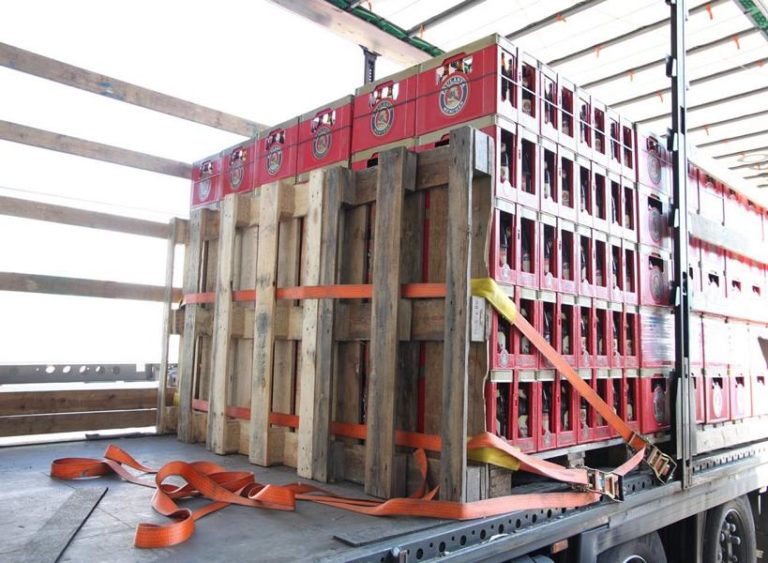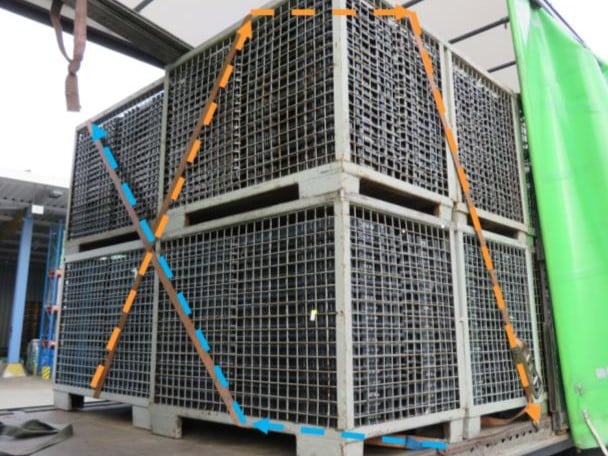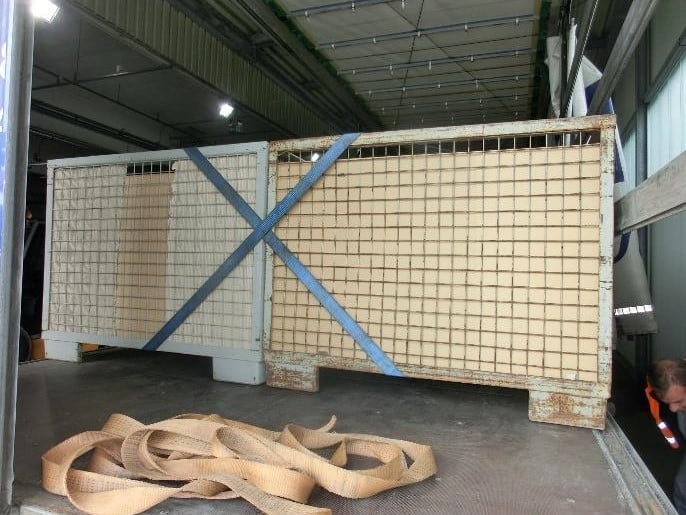
Now 10% off all Ergolash lashing straps save now! Voucher code: ergo10 | Valid until 31.05.2025
If you carefully overtake trucks with open loading areas on the highways, you will mainly see the tie-down method. This is the method that most drivers and shippers are familiar with, but it is also the method that is often not efficient or sufficient.
Of course, you can’t see what’s hidden under the tarpaulins.
An effective but little-known method among drivers/shippers is head lashing or cross lashing. However, head flashing is beginning to gain acceptance in certain sectors. Mostly where the trucks are too heavy rather than full.
Both methods belong to the form-fit spectrum of securing methods.

There are three main differences to tie-down lashing:
1. The LC (lashing capacity) of the securing equipment is used
2. The securing force only becomes effective when the load wants to move.
3. The LC is not reduced by friction
The application of head flashing is simpler, which is why my description begins with it.
With the usual standard lashing straps, the head lashing can only be used with a tarpaulin body or hamburger top. This is not possible with box bodies because in many cases they do not have lashing points on the floor and because the 50 cm fixed end of the strap is too short.
The ratchet is clamped between the load and the side wall. An adapter piece, e.g. a short loose end with hook and eye, would be the solution.
Head flashing is the order of the day if the truck is not completely full.
This means that the distance to the rear portal is greater than 15 cm.

To hold the belt in position, two or three pallets are placed upright against the load, depending on the situation. The pallet feet to the rear.
The pallets should also distribute the force of the belts over a surface. To ensure that the middle pallet receives pressure from the belt tension, the belt should run past the outside.

Attach the strap(s) in such a way that the lashing angle α is always less than 45°.
If greater securing forces are required, a second belt can be attached.

Head lashing is also well suited to securing the load in the direction of travel against pre-loading.
The front load is often not stable enough to stow positively against it.
In this case, it is important to keep a small distance from the preload so that movement within the scope of the belt elongation remains uncritical.
The possible securing force essentially depends on the LC of the lashing points. If a belt with an LC of 2,000 daN is used, a securing force of 2×2,000 daN can be expected.
The frictional force should not be taken into account in the rough calculation; this is the reserve force for inaccuracies or for the loss of force due to the lashing angle.
If a belt with an LC of 2,500 daN is used, only the LC of the lashing points may be used, unless it can be proven that they hold more. The weakest link in the safety chain must always be observed.
Cross lashing is a method that has a similar effect to head flashing. However, this requires dimensionally stable load units. This method is not suitable for small loading units.
This method is a good solution for industries that load pallet cages.

With pallet cages, it is important to attach the straps before the last row of loads is loaded.

The belts are then routed crosswise upwards, over the upper corners of the pallet cage and back to the loading area. In order to achieve the flattest possible lashing angle, the belt length should be utilized as far as possible.

The optimum effect is achieved when the pallet cages are only stowed in a single layer.
As many drivers have little experience with these methods and therefore often reject them and want to lash them down, it makes sense for shippers to draw up loading instructions with pictures.
This is more likely to convince drivers. In general, the language barrier between driver and shipper makes it necessary to work with images.
It is best if the individual phases are presented step by step. Print out these instructions, laminate them and have them ready at the forklift.
This approach has proven itself in practice.
Yours, Sigurd Ehringer
<< Previous article
Episode 33: Problem treatments – using blocking agents correctly

Sigurd Ehringer
✔ VDI-zertifizierter Ausbilder für Ladungssicherung ✔ Fachbuch-Autor ✔ 8 Jahre Projektmanager ✔ 12 Jahre bei der Bundeswehr (Kompaniechef) ✔ 20 Jahre Vertriebserfahrung ✔ seit 1996 Berater/Ausbilder in der Logistik ✔ 44 Jahre Ausbilder/Trainer in verschiedenen Bereichen —> In einer Reihe von Fachbeiträgen aus der Praxis, zu Themen rund um den Container und LKW, erhalten Sie Profiwissen aus erster Hand. Wie sichert man Ladung korrekt und was sind die Grundlagen der Ladungssicherung? Erarbeitet und vorgestellt werden sie von Sigurd Ehringer, Inhaber von SE-LogCon.
Rothschenk assortment
Our customer center has only one goal: to turn your problems into solutions. Whether standard stowage cushions, bestsellers or load securing personally tailored to your needs -. we accompany you consistently from A as in field service to Z as in certification. That is our promise to you, as a leader in our industry.
We attach great importance to professional cargo securing. That is why we have our own production, which ensures reliable operation through modern manufacturing technologies and strict quality control. Thus, we offer our customers a comprehensive and high-quality range of services in the field of transport logistics.
DIN ISO 9001:2015, EMAS and Ecovadis are not foreign words to you? Then it's time to work with the best.
You don't take any risks with us - we have been awarded the Platinum Medal on the EcoVadis sustainability rating platform.
As a load securement company, we are proud to have several certifications that validate our sustainability efforts and our commitment to environmental protection and social responsibility. For you as a purchaser, this means that we demand and promote the implementation of high environmental and social standards both within the company and along the supply chain.
You are currently viewing a placeholder content from Google Maps. To access the actual content, click the button below. Please note that doing so will share data with third-party providers.
More Information